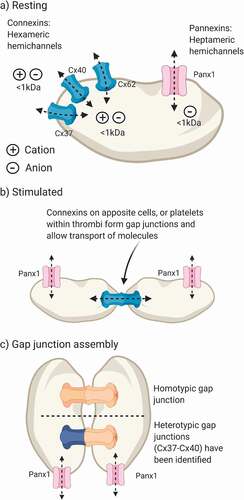Figures & data
Figure 1. Expression and assembly of platelet connexins and pannexin-1. (a) Platelets express Cx37, Cx40 and Cx62 and pannexin-1 (Panx1). Connexins form nonselective hexameric hemichannels and pannexin-1 forms heptameric anion-selective channels that are detected at the plasma membrane. (b) Docking of two apposite hemichannels forms a gap junction that facilitates intercellular communication. (c) Gap junctions form between two hemichannels by either homotypic (e.g., Cx37:Cx37) or heterotypic (e.g., Cx37:Cx40) assembly, which may influence gap junction permeability. The molecular identity of platelet gap junctions and whether they are homo/heterotypic has not been studied. Panx1 cannot form gap junctions due to glycosylation on its second extracellular loop. Created in BioRender

Figure 2. Proposed mechanisms for regulation of platelet connexins and pannexin-1. (a) Phosphorylation- Pannexin-1 (Panx1) is phosphorylated by Src Family Kinases (SFKs) at Y308, leading to channel opening. Platelet connexins have predicted phosphorylation protein kinase C (PKC) sites and Cx62 may interact with protein kinase A (PKA). (b) Gating by Ca+- Connexin hemichannels are open in the absence of extracellular Ca2+ ([Ca2+o) and close when [Ca2+]o rises to 2–4 mM. Panx1 channels open in response to a rise of intracellular Ca2+ ([Ca2+]i) that leads to ATP release and stimulation of P2X1 on platelets. (c) Enzymatic cleavage- The intracellular C-terminus of Panx1 contains a zymogen site that is cleaved by caspase-3, removing an auto inhibitory domain, facilitating channel activation and ATP release. (d) Mechanical stimulation- Mechanical deformation and elevated shear stress have been shown to stimulate Panx1 channels. Studies of cardiac muscle report increased expression of Cx43 following sustained exposure to shear stress. (e) Protein trafficking- Connexins are expressed at the plasma membrane for relatively short periods (half-life (T1/2) = 1.5–3 hours) and are trafficked and recycling in response to cellular activation. Panx1 is stably expressed at the plasma membrane with a T1/2 of approximately 24 hours. Created in BioRender
![Figure 2. Proposed mechanisms for regulation of platelet connexins and pannexin-1. (a) Phosphorylation- Pannexin-1 (Panx1) is phosphorylated by Src Family Kinases (SFKs) at Y308, leading to channel opening. Platelet connexins have predicted phosphorylation protein kinase C (PKC) sites and Cx62 may interact with protein kinase A (PKA). (b) Gating by Ca+- Connexin hemichannels are open in the absence of extracellular Ca2+ ([Ca2+o) and close when [Ca2+]o rises to 2–4 mM. Panx1 channels open in response to a rise of intracellular Ca2+ ([Ca2+]i) that leads to ATP release and stimulation of P2X1 on platelets. (c) Enzymatic cleavage- The intracellular C-terminus of Panx1 contains a zymogen site that is cleaved by caspase-3, removing an auto inhibitory domain, facilitating channel activation and ATP release. (d) Mechanical stimulation- Mechanical deformation and elevated shear stress have been shown to stimulate Panx1 channels. Studies of cardiac muscle report increased expression of Cx43 following sustained exposure to shear stress. (e) Protein trafficking- Connexins are expressed at the plasma membrane for relatively short periods (half-life (T1/2) = 1.5–3 hours) and are trafficked and recycling in response to cellular activation. Panx1 is stably expressed at the plasma membrane with a T1/2 of approximately 24 hours. Created in BioRender](/cms/asset/c31bd054-aa40-441a-bcfc-681e4ef0fa47/iplt_a_1902971_f0002_oc.jpg)
